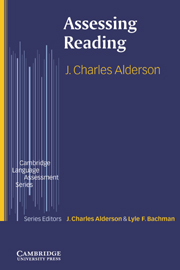Book contents
- Frontmatter
- Contents
- Series Editor's Preface
- Acknowledgements
- Abbreviations
- 1 The nature of reading
- 2 Variables that affect the nature of reading
- 3 Research into the assessment of reading
- 4 The reader: defining the construct of reading ability
- 5 A framework for test design
- 6 Tests in the real world: test purposes
- 7 Techniques for testing reading
- 8 The development of reading ability
- 9 The way forward. Assessing the interation between reader and text: processes and strategies
- Bibliography
- Index
7 - Techniques for testing reading
Published online by Cambridge University Press: 03 May 2010
- Frontmatter
- Contents
- Series Editor's Preface
- Acknowledgements
- Abbreviations
- 1 The nature of reading
- 2 Variables that affect the nature of reading
- 3 Research into the assessment of reading
- 4 The reader: defining the construct of reading ability
- 5 A framework for test design
- 6 Tests in the real world: test purposes
- 7 Techniques for testing reading
- 8 The development of reading ability
- 9 The way forward. Assessing the interation between reader and text: processes and strategies
- Bibliography
- Index
Summary
Introduction
In this chapter I shall use the terms ‘test method’, ‘test technique’ and ‘test format’ more or less synonymously, as the testing literature in general is unclear as to any possible difference between them. Moreover, it is increasingly commonplace (for example in test specifications and handbooks) to refer to ‘tasks’ and ‘task types’, and to avoid the use of the word ‘technique’ altogether. I feel, however, that there is value in conceiving of tasks differently from techniques: Chapters 5 and 6 have illustrated at length what is meant by ‘task’. A task can take a number of different formats, or utilise a number of different techniques. These are the subject of the current chapter.
Many textbooks on language testing (see, for example, Heaton, 1988; Hughes, 1989; Oller, 1979; Weir, 1990 and 1993) give examples of testing techniques that might be used to assess language. Fewer discuss the relationship between the technique chosen and the construct being tested. Fewer still discuss in any depth the issue of test method effect, and the fact that different testing techniques or formats may themselves test non–linguistic cognitive abilities or give rise to affective responses, both of which are usually thought to be extraneous to the testing of language abilities. Moreover, it is conceivable that different testing techniques permit the measurement of different aspects of the construct being assessed. Therefore, it is important to consider what techniques are capable of assessing, as well as what they might typically assess.
- Type
- Chapter
- Information
- Assessing Reading , pp. 202 - 270Publisher: Cambridge University PressPrint publication year: 2000
- 1
- Cited by



